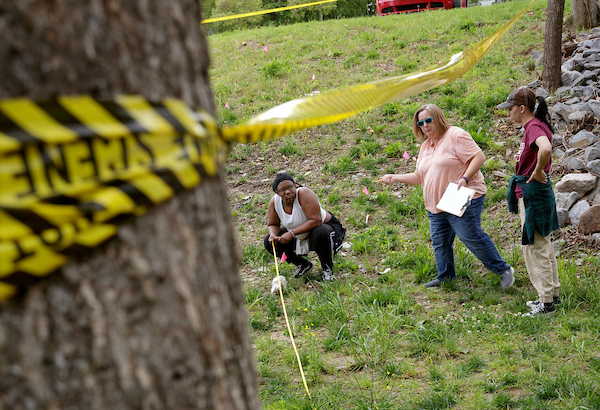Forensic Anthropology Students Test Out CSI Skills at Mock Crime Scene

It was a windswept, dark cloudy Thursday afternoon, and the gloomy weather seemed a precursor to the grim scene found near the lonely banks of Coleman Creek on the University of Arkansas at Little Rock campus.
Marked off by police tape, four investigators scoured the scene, using small yellow flags to mark off pieces of bone and physical evidence found near skeletal human remains.
While it sounds like the start of an episode of “CSI,” it remains an innovative teaching exercise designed to foster student learning and success. Professor Katie King created a mock crime scene for her forensic anthropology students, a chance for them to test out their classroom skills in the real world, or at least as real as a crime scene utilizing a Halloween decoration can be.
The “victim” is a Halloween skeleton that King bought on clearance but put to good use. The exercise is meant to teach the students about what might happen if they work at a crime scene where skeletal remains have been found after being outside for an extended period.
“We are reenacting what might have happened if someone were to find a body,” King said. “Using their knowledge, the students are trying to find evidence. This includes bones and items like cigarette buds and bottles that might contain DNA.”
In King’s mock crime scene scenario, the murder victim died from a gunshot wound to the head, was dismembered with power tools, and then dumped out in the woods for at least a month before being discovered. The remains were scattered due to animals, weather, and being located on a hill.
UA Little Rock students completed a surface survey to look for skeletal remains and evidence. They painstakingly marked out 24 pieces of evidence that King planted herself. They then mapped the area so they can later recreate the crime scene. While this was the end of the student exercise, King said the next step for investigators would be to take the evidence back to the lab to examine it for DNA.
Paige Blair, a junior anthropology major at UA Little Rock, said that participating in the mock crime scene was a great way for her to gain some practical anthropological experience.
“I’ll be attending a field methods course in forensic anthropology at the University of Knoxville this summer, and I feel like this is good preparation for me,” Blair said. “I think this is a great way to teach, rather than just having us read out of a book.”
